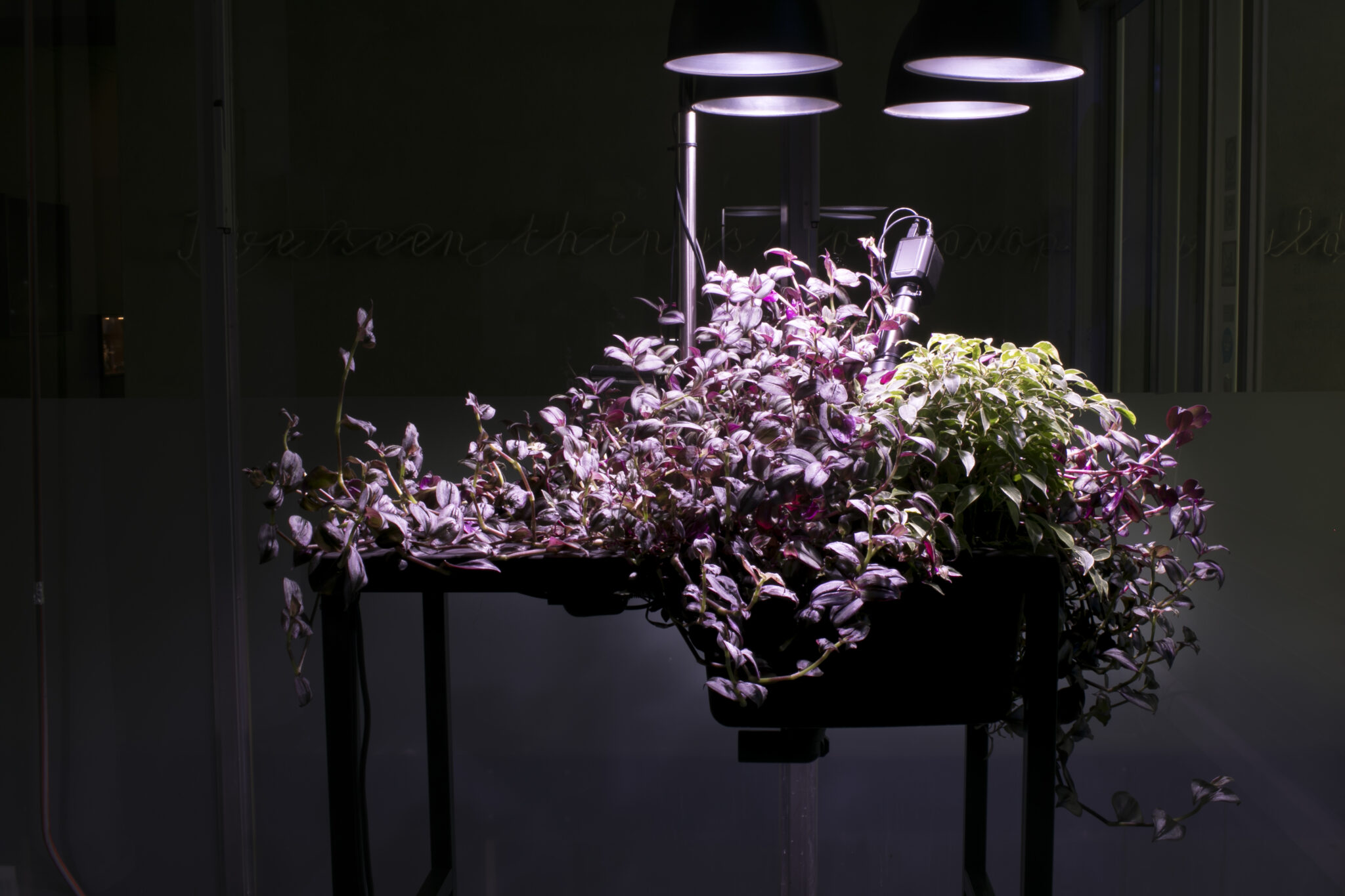
SANS RÉSERVE – 2025
COAL is pleased to announce the third edition of SANS RÉSERVE, the unmissable gathering for art and ecology, presented from…
Image credits: Špela Petrič Nociceptor :branje ustnic Galerija Kapelica
Published on 5 June 2020
As part of the COAL 2020 Award, ten artists’ projects have been nominated as finalists for this eleventh edition. Each day, we offer you a meeting with one of the nominated projects, until the winner is announced.
Špela Petrič was born in 1980 in Ljubljana, Slovenia. She lives and works between Ljubljana and Amsterdam.
Špela Petrič, trained in natural sciences and holding a PhD in biochemistry and molecular biology, is mainly dedicated to exploring new media. His artistic practice combines the different natural sciences and questions the limits of anthropocentrism through attempts at inter-species dialogue. By experimenting with unexpected artistic and scientific processes, she reveals the ontological and epistemological foundations of our technological societies. She has received several awards, such as the White Aphroid in Slovenia, the Bioart and Design Award (The Netherlands) and an award of distinction at Prix Ars Electronica (Austria).
PROJECT NOMINATED FOR THE COAL 2020 AWARD : PL’AI
How can we invent new ways of caring for earthly life forms, at a time when computer abstraction and algorithmic governance have become our common reality? How can we respond to the profound contempt of the contemporary world for plants, neglecting their evolutionary capacities, their resilience and their crucial role in the biosphere?
To combat solastalgia, the contemporary eco-anxiety caused by environmental change, an interdisciplinary team of artists, scientists, engineers and programmers is attempting to answer these questions by creating plant-machines, robots capable of seeing themselves as plants. Through these plant-machines, PL’AI playfully investigates the behavior of plants to facilitate new interactions between the plant world and computer technologies, such as machine learning and artificial intelligence. A self-learning computer algorithm and mechanical appendages allow to enter the time and rhythm of the plant to play with it.
PL’AI invites the visitor to an original show, that of a game between a pea plant and an artificial intelligence (AI), the latter being able to know the plant, to predict its evolution, its growth, until retracting before the pea tendril clings to it. In real time, neither the machine nor the plant will seem to move, but thanks to a time-lapse video, the interplay between the artificial intelligence and the growing pea plant becomes perceptible.
The meeting between a plant and a robot, between non-human living entities and the digital and algorithmic universe, invites us to go beyond our human cultural and physical limits and to consider living creatures in a new light.
Describe your current environment, how do you live this covid-19 era?
I am currently in Amsterdam, and although the Netherlands has not imposed any restrictive measures on travel, I stay indoors most of the time.
Does this situation influence your artistic practice?
This pandemic is as disconcerting as it is fascinating to observe. Societal and political processes, which in other cases would have gone unnoticed, are now exposed. Of course, this implies the responsibility to act, to react, but how can we make sense of anything when we are faced with a tumult of bad information and emotions? For now, I welcome being overwhelmed, and letting the observations, readings and my sensibilities flow through me. Coincidentally, this is the perfect time to slow down, and this spring time is perfect for observing plants, their rebirth activity: a crucial task for my art, but an impossible luxury under normal circumstances.
Can you tell us about a particular event that influenced your relationship with nature and biodiversity?
I think there are many examples that have shaped my nuanced affection for living creatures. Beyond the joy and fascination of childhood, which almost everyone experiences, I was confronted with biodiversity through the lens of my studies. By observing ecosystems, biology teaches the aesthetics of abundance and the resilience that emerges from complexly woven relationships. In this sense, a biologist is rarely as neutral as science suggests – and for good reason, since we humans depend on the stability of these processes.
However, as I delved into the origins and uses of terms such as “biodiversity,” “ecosystem services,” or “nature” during my bioart practice, I realized that these concepts were situated in time and space, and emerged from different environmental conservation traditions. For example, the fields of Eastern Europe are a hotspot for biodiversity, but they are anthropogenic – without regular cutting or grazing, forests are rapidly invading them. Nature conservation is usually understood through the North American model of avoiding human intervention as much as possible, a model that has been used in the past for dubious purposes, for example to legitimize the deportation of indigenous peoples from the “pristine” Yellowstone National Park. Nature conservation is messy and culture-specific, which makes it even more enigmatic and difficult to act when talking about biodiversity in a universal and global sense.
How do you combine technology and nature in your work? You compare it to a game of hide and seek, could we also talk about a game of chess?
Because of the way technology is steeped in history, it pushes us toward certain uses and not others. This perpetuates certain views that are easy but hard to change. Given the role that technology has played in our contemporary awareness of nature (the vast machine of sensors, algorithms, and people that produce images of climate change; startling photos of endangered species; the computer models that update agricultural decision-making, etc.), it is important that the relationship between technology and living creatures be re-examined and reworked, and that our attitudes toward them change.
PL’AI is an installation that aspires to create the conditions for a game between a climbing plant and a robot driven by artificial intelligence. Unlike the productivity-oriented artificial intelligences that are currently at the forefront of agriculture, we have come to understand that plants exhibit very complex behavior that cannot be reduced to simple objectives. We need machine-learning here, because the trans-species game we propose escapes a logical, biological or aesthetic definition. In other words, we are interested in the enchantment dimension, where the plant and the artificial intelligence teach each other the rules of the game and show us how they play together.
What role do you see for artificial intelligence in protecting biodiversity?
We are living in a particularly interesting moment where computing coupled with big data has become a highly effective instrument for predicting and directing social behavior – in other words, a tool for governance. I mention this because it links to my first observation: that the decision that biodiversity should be protected still rests with people and their policies. As has been noted in animal studies, the only way to participate in human politics is through the use of language, which automatically excludes all those who cannot speak. Wouldn’t it be more radically relevant in this day and age, if rivers, ecosystems, fungal mycelia, lion pride or forests could somehow participate directly in the political arena, without needing to be represented (although considering forests or rivers as legal entities is already a big step in environmental justice)? Or as the Terra0 art project suggests, that a forest must sell its wood to buy the land on which it grows?
What is striking about this concept is that as artificial intelligences become more and more powerful hands, we are fighting for transparency, representation, privacy, equality, and justice without the help of algorithms. When we design “personal artificial intelligences” that would represent our individual interests and make digital ecosystems socially responsible, we need to think of ways to grant this possibility to non-human entities as well. After all, computers don’t care who the data comes from. The challenge is to consider how artificial intelligences could become the voice of a coral reef, a rainforest or a meadow.
What is your relationship to environmental commitment as an artist and citizen?
I think our societies have been in systematic denial about our dependence on the environment for too long, intoxicated by the promise of control through scientific and technological progress. But, while we downplay the environmental institution, at the same time we observe how biodiversity loss, extractive practices, and monoculture agriculture contribute to disasters such as the covid-19 pandemic, antibiotic resistance, desertification, and climate change migration. Environmental commitment, which blurs the boundaries between my professional and private life, means for me to learn to live closely with agents and processes that may appear as a decoration but are in fact constitutional and indispensable to our existence.
I chose to work with plants precisely because I was disinterested in them. This metamorphosis began 6 years ago, when I wanted to understand how I could be insensitive to the organisms that are literally the lifeline of the entire biosphere. The journey through artistic research and creation has taught me not only to appreciate the plant being, but also the banal actions of discarding that we perform, unaware that through this, we maintain attitudes detrimental to the environment. I strive to create opportunities for encounters that surprise and attract, so that people can – in their own way – find a path to a familiarity with unlikely places that would reveal how ecology and economy can be articulated to care for what we depend on.
How do you imagine the world to come?
This is a difficult question, because what we imagine of the future is so light and ideological compared to the whirlwind it will be. I guess I’ve already talked a lot about my desires, so maybe all I can add is that I would like to be pleasantly surprised. I look forward to events that would surprise us, but not only with disastrous effects. I would like to meet unexpected allies that would make the world a more interesting, open, diverse and welcoming place.
COAL is pleased to announce the third edition of SANS RÉSERVE, the unmissable gathering for art and ecology, presented from…
COAL is delighted to announce the ten French and international artists nominated for the 2025 edition of the COAL Prize,…
COAL is delighted to announce the names of the students from French art and culture schools nominated for the sixth…


